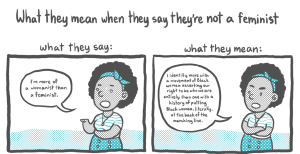Speaker 1: Look at this note. It’s from the Blue Book Modeling Agency in 1945. It says: “Norma Jean – who you might also know as Marilyn Monroe – was, in fact, a size twelve.”
Lynn Boorady, PhD: She was. But back in the ’50s, a size twelve was very thin. That was a model. You know, a size twelve then would be about a size six now.
Text: 36-24-34
Speaker 1: Well, to be exact, she would be a size eight at Topshop, six at Zara, and four to six at American Apparel. To actually show you the inconsistencies, I went shopping. I bought three jeans at three different stores, all in the same size.
We’re already off to a bad start. These all look different. This is not a four. This one is the one in the middle. This one fits. Hold up. It won’t zip. I give up.
Let’s wind back a little bit.
It was the Napoleonic Wars – and later, the Civil War in the US – that demanded a sizing system for the mass production of clothing for the first time. It was for men’s uniforms. After that, men’s suit sizes were based on the chest measurement, and the rest was calculated accordingly – assuming that their bodies were in proportion.
The demands for mass production of uniforms escalated, and ready-made clothing became really popular. By the end of the nineteenth century, most people were wearing ready-made clothes. In 1939, the US government funded statisticians to collect the weight and 58 measurements of 15,000 women.
Lynn: They only used white women. Even though they took measurements of women of color, they did not include them in the study or in the calculations. The women who were most likely to turn out for the study were the poor women because they would be paid. So I think the data set, even back then, was possibly malnourished women, certainly poor women, and not very diverse group of women.
And that’s what we started with.
Speaker 1: They were looking for key measurements that could predict the sizes of other parts of the body – the way chest sizes had for men.
But women’s bodies, with variable breast and hip sizes, were much harder to summarize with a single number. So the data was used to create a system in 1958 with sizes from eight to 42 – which was just arbitrary numbers based out of bust size, combined with a letter for height and a plus-minus for hips.
The sizing chart was really unpopular, so they made some updates. But, finally, in 1983, it was completely withdrawn. In the 1970s and ’80s, companies started labeling the sizes down and adding lower numbers like two, zero, and now even a double zero.
So the waist measurement that used to be a size twelve became an eight.
Lynn: Vanity sizing, specifically, is when the size on a label is lowered artificially in order to attempt to get somebody to buy the garment. So you’re appealing to the person’s vanity.
Speaker 1: Sizing became a marketing tool.
Lynn: I think it’s done because the women are getting bigger, and we’re just addressing that.
Speaker 1: When the first standardizing chart came out in 1958, it was mostly built out of malnourished, white women. Now that there’s such a wide group of people to cover, the retailers are picking a certain group of people to sell to, honing in on what works with that group and what doesn’t.
Lynn: I think we’re more aiming for our own target markets. When Abercrombie & Fitch does their sizing, they’re sizing it to their target market, not to me. And we just kept tweaking that information until we sold more garments and could lower the return rate.
Speaker 1: That means that even brands owned by the same company will have inconsistent sizes. A size eight at Banana Republic will have the same hip size as a size two at the Gap. So if you get frustrated while shopping…
Lynn: It’s not you. It’s the industry. And it’s not women’s bodies. We’re fine the way we are. They’re just random numbers. They don’t mean anything. And if you don’t like the size, just cut it out of your clothes.




















